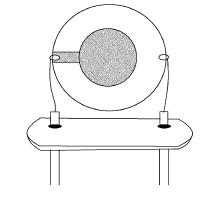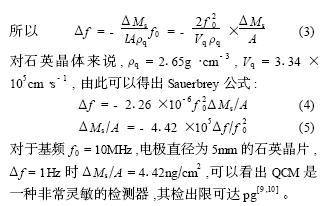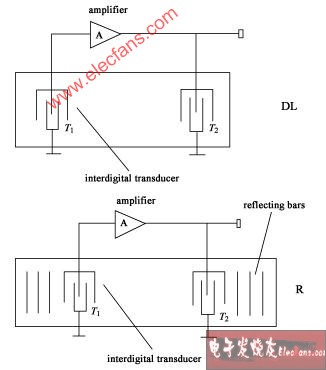Structure and principle of mass-type piezoelectric chemical sensor
1. Bulk Acoustic Wave Chemical Sensor (QCM)

Fig. 1 Quartz wafer with electrodes on QCM Fig. 1 QCM in standard holder
QCM generally uses AT2-cut piezoelectric quartz crystals because their temperature coefficient is zero at room temperature. The QCM device is shown in Figure 1: There is a metal electrode on each surface of the thin piezoelectric crystal plate (Au or Pt is deposited on the upper and lower surfaces of the piezoelectric wafer) and is connected to the resonant circuit. When a resonant electric field is applied to the crystal plate, sound waves are generated. Thickness is the determining factor for frequency changes in this type of device. When there is a material change on the QCM surface (increase or decrease), it can cause a change in the thickness of the device, which in turn causes a change in the resonant frequency, as shown in Figure 2.

M is the mass of the quartz wafer, A is the surface area of the wafer, ρq is the quartz density, f0 is the resonance frequency, ΔMs is the mass of the material deposited on the quartz surface, the vibration frequency of the AT2-cut piezoelectric quartz crystal is f0 = VqP/2l, and Vq is the propagation speed of the shear wave in quartz.

2 Surface Acoustic Wave Chemical Sensor (SAW)
At the end of the 19th century, British scientist Rayleigh discovered sound waves propagating on the surface of solids, namely surface acoustic waves [11] (some literature also calls them surface acoustic waves, or SAW for short). In recent decades, people have gained a deeper understanding of the basic properties of SAW. In 1965, American scientists White and Voltmer [12] invented the metal interdigital transducer (IDT) that can excite surface waves on the surface of piezoelectric crystal materials, making the application of SAW more and more extensive.
SAW sensor is the product of the combination of electronic technology and material science. It consists of SAW oscillator, sensitive interface film material and oscillation circuit. The core component of SAW sensor is SAW oscillator, which consists of piezoelectric material substrate and interdigital transducers with different functions deposited on the substrate. There are two types: delay line type (DL type) and resonator type (R type), as shown in Figure 3:

Fig. 3 Type of SAW sensors
The metal electrode material is evaporated or sputtered onto the piezoelectric substrate in a forked-finger shape, forming a component that generates surface acoustic waves. The surface acoustic waves propagating along the substrate are excited by the forked-finger electrodes. When the substrate or the special is modulated by the object being measured, the operating
frequency of the surface acoustic wave will change and be received by the receiving forked-finger electrodes (via the opposite mechanism), thus forming a frequency output sensor. In 1984, Wohlfjen et al. [13] first proposed the mass response relationship of the surface acoustic wave chemical sensor:

This equation has the same form as the Sauerbrey equation (4), reflecting the effect of mass change on frequency shift, that is, the oscillation frequency decreases as the mass of the adsorbed substance on the substrate or the film covered by the substrate increases. Since the fundamental frequency of QCM can only reach tens of MHz, while the fundamental frequency of SAW can reach GHz level, SAW chemical sensors are more sensitive than QCM chemical sensors, and their detection limit can theoretically reach fg.
From the above, it can be seen that the principle of mass-sensitive piezoelectric chemical sensors QCM and SAW is that when the sensitive element of the sensor interacts with the object being measured, it causes changes in the amplitude, frequency, wave velocity, etc. of the oscillator's own acoustic wave parameters, and the mass P concentration information of the measured quantity is obtained by measuring the frequency change.
Previous article:Surface Acoustic Wave Chemical Sensor (SAW)
Next article:Hall isolation amplifier
- Popular Resources
- Popular amplifiers
- High signal-to-noise ratio MEMS microphone drives artificial intelligence interaction
- Advantages of using a differential-to-single-ended RF amplifier in a transmit signal chain design
- ON Semiconductor CEO Appears at Munich Electronica Show and Launches Treo Platform
- ON Semiconductor Launches Industry-Leading Analog and Mixed-Signal Platform
- Analog Devices ADAQ7767-1 μModule DAQ Solution for Rapid Development of Precision Data Acquisition Systems Now Available at Mouser
- Domestic high-precision, high-speed ADC chips are on the rise
- Microcontrollers that combine Hi-Fi, intelligence and USB multi-channel features – ushering in a new era of digital audio
- Using capacitive PGA, Naxin Micro launches high-precision multi-channel 24/16-bit Δ-Σ ADC
- Fully Differential Amplifier Provides High Voltage, Low Noise Signals for Precision Data Acquisition Signal Chain
- LED chemical incompatibility test to see which chemicals LEDs can be used with
- Application of ARM9 hardware coprocessor on WinCE embedded motherboard
- What are the key points for selecting rotor flowmeter?
- LM317 high power charger circuit
- A brief analysis of Embest's application and development of embedded medical devices
- Single-phase RC protection circuit
- stm32 PVD programmable voltage monitor
- Introduction and measurement of edge trigger and level trigger of 51 single chip microcomputer
- Improved design of Linux system software shell protection technology
- What to do if the ABB robot protection device stops
- CGD and Qorvo to jointly revolutionize motor control solutions
- CGD and Qorvo to jointly revolutionize motor control solutions
- Keysight Technologies FieldFox handheld analyzer with VDI spread spectrum module to achieve millimeter wave analysis function
- Infineon's PASCO2V15 XENSIV PAS CO2 5V Sensor Now Available at Mouser for Accurate CO2 Level Measurement
- Advanced gameplay, Harting takes your PCB board connection to a new level!
- Advanced gameplay, Harting takes your PCB board connection to a new level!
- A new chapter in Great Wall Motors R&D: solid-state battery technology leads the future
- Naxin Micro provides full-scenario GaN driver IC solutions
- Interpreting Huawei’s new solid-state battery patent, will it challenge CATL in 2030?
- Are pure electric/plug-in hybrid vehicles going crazy? A Chinese company has launched the world's first -40℃ dischargeable hybrid battery that is not afraid of cold
- [Design of online monitoring system] TouchGFX touch point based on STM32H7B3-DK...
- Phase noise basics and test principles and methods as frequency source (LO)
- nanoPower technology: Extend battery life and improve sensor performance. Registration for the January 20 seminar is open~
- STM32L151C8T6 cannot enter serial port interrupt
- How to simulate the sound control circuit in Proteus? Please guide me, thank you.
- Moderator Rewards Announcement for March and April 2019
- Switching Circuit
- [RVB2601 Creative Application Development] My Guitar Environmental Protector - Automatic Dry and Humidity Regulator
- 【NXP Rapid IoT Review】 NO2. Experience Sharing of Mobile App BLE Control Development Kit
- What is the role of Zigbee wireless data transmission module in wireless personal area network?

 LMC6081AIMX
LMC6081AIMX
















 京公网安备 11010802033920号
京公网安备 11010802033920号